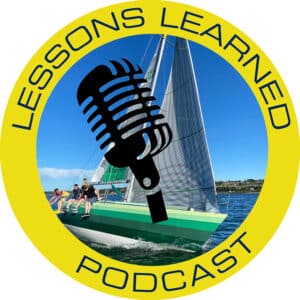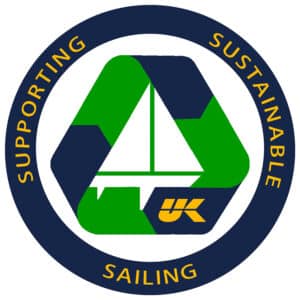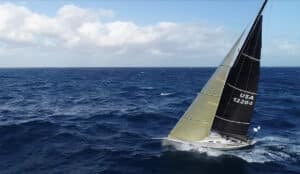On April 9, UK Sailmakers on our website posted an instructional How-To article about how to execute a Mexican spinnaker takedown. Click HERE. As an aside at the end of that article, we recounted the popular lore that it was “invented” and named by Buddy Melges sailing America3 off San Diego in the 1992 America’s Cup trials doing modified float takedowns in leeward port roundings and ending-up pointing at Mexico afterwards. This same article noted that “Down Under,” these takedowns are referred to as Kiwi drops. Ever curious, we floated the challenge for someone to explain the derivation of the Kiwi nomenclature. To our glee, Freemantle, WA, sailor Mark Wheeler, with subsequent input from David Clark, responded with the answer…and more.
Stick with us here as we connect the dots:
• Dave says that the ‘Kiwi’ was actually invented by mistake!! This was during the run-up to the ’87 America’s Cup series (in mid-86) in 12 Meters in Fremantle. When debriefing a video of a bottom mark ‘cluster’ with their coach (after having gone late into late bottom mark gybe, starboard approach at bottom for left turn…delay dropping chute until just on/after gybing), they decided it was actually a handy maneuver.
• The Kiwis were racing KZ5 vs. KZ3 in two boat-testing/training. Dave wasn’t 100% sure which boat accidentally executed it, but KZ3 was skippered by Graeme Woodroff and KZ5 by Chris Dickson, prior to Chris being named as the Kiwi Magic skipper. This would have been ‘early to mid-1986,” prior to the launch of KZ7 – Kiwi Magic.
• The Kiwi drop quickly transitioned to the match racing circuit and was used more frequently there – smaller boat / sails and often coming in on starboard for a port rounding and having a knife fight to get around the mark. So…a full five years before Melges is credited for having ‘invented’ it.
Not ones to let a sleeping dog lie, we went back to Mark with more questions and got some rousing responses from the Aussie. Here goes:
UK: How come nobody down under put up a stink with Buddy Melges getting all the credit for creating this gybe takedown?
MW: Who’s Buddy Melges? 🙂 Everything Kiwi becomes Australian (Pavlova, Crowded House, Russell Crowe, etc.). We had to let the Kiwi’s have something! “Mexican” only appeared back in Australia recently (last 10 years) when some of the pro’s started to call it that to all our bewilderment. “What the #$%^ is a Mexican?” The names are really interchangeable, but we still prefer “Kiwi” because we call Victorian’s (people from the Australian state of Victoria) “Mexicans” – south of the border – as a term of endearment!
UK: Originally done on boats with poles, how soon did they realize how great it would be for asym / sport boats?
MW: The 18-foot and 1-foot’ skiffs seemed to be the first to use A-sails and, because there were a lot of skiff sailors in the 1987 America’s Cup, it made a quick transition to that class and beyond in the late 80’s.
UK: What other boat handling “inventions” did you guys discover of this magnitude that set a path for others (like me) to follow?
MW: Wow, what a great question! I would have to say (with impunity) that the boat handling on Australia II in 1983 revolutionized sailing a big boat with 11 guys. Their techniques spread and got refined from there. Many of the things that we take as common place today, came from there and then were ‘institutionalized’ and perfected in the training for AC87 where the daily breezes were above 20 knots including:
-
We all found that at 12 knots, the boats were so powered up with maximum sail area that the workloads were the highest. Above 12 then really everything was above 18knots and sails got smaller, and the whole thing got a bit easier really.
-
Australia II was the first team to have navigators and tacticians go forward, windward trimmers to grind at the bottom mark rounding, the ‘Lexcen line’ (it’s still secret :), line guides onto winches to stop overrides, line retractors on drums, rollers in the forward hatches, foot pedals for sheet clutches (didn’t have enough winches for peeling).
-
Instead of short sheeting the genoa on a bear away to free up the winch, we used a ‘clam cleat under the sheet and you eased and pushed the sheet into the cleat – voila, a free winch!
-
Takedown lines from multiple locations on the chute,
-
Jib Cunninghams for leeward changes,
-
Mousing out halyards upwind,
-
The technique of casting off and tailing on the genoa – this was perfected by the Kookaburra guys and everybody copied them,
-
Counterclockwise winches on port side,
-
Load cells on forestays for runner load, and it goes on…
The boat handling and who does what on an 11-man boat was perfected to a fine art during this regatta and then its spread to match racing and big boat sailing by osmosis.
UK: Are there any other anecdotes you can share about the early Kiwi drops going wrong?
This sequence shows a smooth Mexican / Kiwi drop. Photos Copyright: www.DallasJohnson.net
.
MW: The trickiest part of the whole deal is where does the mastman and the bowman stand as the boat rounds? The sewerman is below, but these two guys have to end-up on the windward side of the chute as it backwinds and slides down the genoa. Normally the foot of the chute is pretty high on a 12 Meter but, if the pit lets the halyard go too soon, as he was prone to do (because there is a lot of it to come down), and the genoa doesn’t come in and close the gap, there is plenty that can go wrong.
If not choreographed and timed right, both these guys could end-up somewhere in the sail and, more often than not, downstairs or overboard wrapped in the sail. I can remember thinking that we had lost our bowman overboard a couple of times only later to find him wrapped-up tightly in a sail or worse. One time the bowman actually was swept overboard, wrapped in the sail. As we struggled to get him back on board as the genoa was then trimmed in, he came back aboard nicely wrapped up like an enchilada stuck outside the leeward rail and outside the genoa. (I won’t name names 😉).
I can’t remember actually ever doing a Kiwi in anger on a 12 Meter because we were (unfortunately) never that close as a bottom mark. However, about 1 in 3 takedowns on the match racing circuit were Kiwis and they never had a problem on the 40′ ish boats.
If you have more to share on this story, send your thoughts to Info@UKSailmakers.com.





I once saw a ‘not-a-Kiwi’ takedown, but one invented in an instant of necessity and inspiration: a tack windard takedown.
The last race of the Etchells Worlds, 1986 was sailed in a light northerly, but as the leaders approached the leeward mark, way out in Lake Ontario, the southerly system breeze pushed in. There was a dead zone about 200 yards from the mark, with a light northerly, north of it, and a light southerly around the mark. The first six or so boats were well gapped away from the rest of the fleet and were the first to douse their spinnakers and beat the last stretch to the mark and round almost nose to tail.
Everyone then, in order, re-set their spinnakers on starboard and headed north. Bruce Burton, with Glenn Burton and Chris Lucander were about fifth in this group. The lead boats were successively headed to the west as they coasted into the dead zone. There were boats, each flying spinnakers, headed in reciprocal directions, within 30 yards of each other!
As Burton reached the edge of the northerly with the pole almost on the forestay, he TACKED, let the guy run, and came out on starboard, on the breeze.
Just like a good ‘Kiwi’, the chute slid down the now windward face of the jib and was recovered almost instantly by Glenn and Chris. They had not dropped the jib, so I suspect that the only to-be-trimmed items were the backstay, main and jib sheets.
This put Burton on the major tack with an instant 8 or 9 boat-length lead (ahead and to leeward) of the others . They went on to win the race, and clinched their second World Championship.
As those circumstances are sorta kinda rare, I don’t think it has, or will happen too often. And since it was an Etchells, the spin pole was not a problem. It was a neat and surprising thing to see, which is why I remember it.
I once saw a ‘not-a-Kiwi’ takedown, but one invented in an instant of necessity and inspiration: a tack windard takedown.
The last race of the Etchells Worlds, 1986 was sailed in a light northerly, but as the leaders approached the leeward mark, way out in Lake Ontario, the southerly system breeze pushed in. There was a dead zone about 200 yards from the mark, with a light northerly, north of it, and a light southerly around the mark. The first six or so boats were well gapped away from the rest of the fleet and were the first to douse their spinnakers and beat the last stretch to the mark and round almost nose to tail.
Everyone then, in order, re-set their spinnakers on starboard and headed north. Bruce Burton, with Glenn Burton and Chris Lucander were about fifth in this group. The lead boats were successively headed to the west as they coasted into the dead zone. There were boats, each flying spinnakers, headed in reciprocal directions, within 30 yards of each other!
As Burton reached the edge of the northerly with the pole almost on the forestay, he TACKED, let the guy run, and came out on starboard, on the breeze.
Just like a good ‘Kiwi’, the chute slid down the now windward face of the jib and was recovered almost instantly by Glenn and Chris. They had not dropped the jib, so I suspect that the only to-be-trimmed items were the backstay, main and jib sheets.
This put Burton on the major tack with an instant 8 or 9 boat-length lead (ahead and to leeward) of the others . They went on to win the race, and clinched their second World Championship.
As those circumstances are sorta kinda rare, I don’t think it has, or will happen too often. And since it was an Etchells, the spin pole was not a problem. It was a neat and surprising thing to see, which is why I remember it.
Arrgh, came out on port!
My lysdexia is getting the better of me today!
Arrgh, came out on port!
My lysdexia is getting the better of me today!
Yes, I learned the Kiwi drop on my asymmetrical Bull 7000 from Greg Young, but sometimes the sheet would not come around the headstay smoothly until Keith Musto invented the Musto strop. Probably on the Melges 24 and it must have been him, why else is it called in my sailing world the „Musto strop“. It is a thin high load rope which is spliced or used with a thin knot into the clew. Thus it slips around the headstay without holding friction and coming the thicker sheet (knot) the wind in the sail blows it back to execute a perfect Kiwi.
Yes, I learned the Kiwi drop on my asymmetrical Bull 7000 from Greg Young, but sometimes the sheet would not come around the headstay smoothly until Keith Musto invented the Musto strop. Probably on the Melges 24 and it must have been him, why else is it called in my sailing world the „Musto strop“. It is a thin high load rope which is spliced or used with a thin knot into the clew. Thus it slips around the headstay without holding friction and coming the thicker sheet (knot) the wind in the sail blows it back to execute a perfect Kiwi.